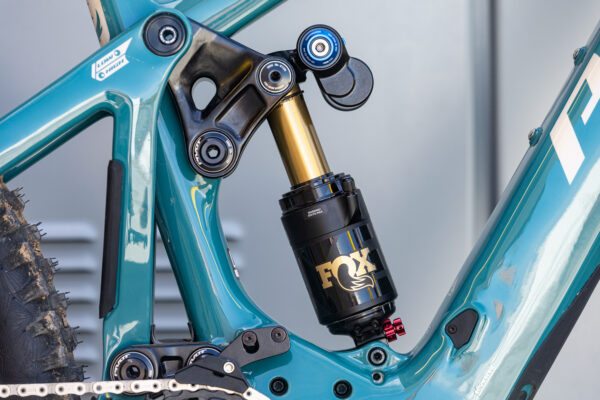Fox's halo gravity shocks, the Float X2 and DHX2, get a total redesign, in the quest for new levels of downhill performance.
Shock news! Literally! Fox’s latest Float X2 (and DHX2) moves from a twin-tube design to a monotube, with over 100 new parts, and the end goal of improving both reliability and performance. It’s already one of the best shocks you can buy, so a lot’s at stake with this complete overhaul.

The new Fox Float X2 shock looks pretty similar to the old one, but it’s completely different under the hood.
Fox Float X2 need to know
- New chassis and internals with monotube design
- Pressure balanced damping circuit reduces cavitation and improves response and control
- Four-way adjustability
- Larger base valve with more 50 shims (2x old shock) increases tunability
- Stronger main shaft
- Micro-adjust volume spacers
- Max pressure now 350psi
- Weight from 720g
- Priced at £849 for the Factory version
The changes to the Float X2 air shock are also applied to the DHX2 coil shock, with the obvious exception that the Float X2 has an air chamber surrounding the damper, whereas the DHX2 uses a coil spring. Now let’s run through the main changes on the new Float X2 and delve into why Fox has made them.

The bigger piggyback is a giveaway on the new Fox Float X2 shock, as is the dual rebound knob at the base of the shock.
Why monotube?
Before going into the reasons for switching to a monotube damper design, I should probably explain what a twin-tube damper is. To imagine the difference, it’s worth thinking of a coil shock, rather than an air shock, because the air chamber can confuse things with the latter.
As the name suggests, in a twin tube design the main damper piston slides up and down inside a tube within a tube. As the piston moves, it displaces some oil from the inner tube to the outer tube – obviously some also moves through the valves/shims. However, this design is difficult to manufacture and package, and with less space to play with, parts like the piston shaft have to be reduced in size. All of which has an impact on strength and reliability.

Retaining the high and low-speed rebound adjustment was not easy, but having the new clickers next to each other, with tool-free operation, is an advantage.
The old Float X2 had issues with losing air pressure and breaking pistons on bikes with shock extenders, and while Fox says it has solved those issues on recent iterations, moving to a monotube allows everything to be beefed up. For example, the main damper shaft is now 12.7mm in diameter, up from of 9.5mm.

The internals. Clockwise from far left we have the main piston assembly (with exploded shim stack), top right is the compression valve (with exploded shim stack), and bottom right is the main piston, the IFP (red) and the compression valve (blue).
A monotube damper is just a single chamber with the piston moving within it. At the opposite end from the piston is the IFP (internal floating piston) that keeps the oil under pressure to reduce cavitation (air bubbles forming in the oil).
So the monotube makes it easier for Fox to beef up the internals, and improve manufacturing consistency. Additionally, it can pressure balance the two sides of the damper, which can bring multiple performance benefits.

The climb switch adds a pedal platform for long, smooth climbs.
What is pressure balancing?
Pressure balancing is a technique where a suspension manufacturer or tuner attempts to equalise the pressure across both sides of the main piston. Obviously, as the damper compresses, there’s greater pressure on the positive side of the piston than the negative. By measuring the pressure at different points, while cycling the damper at different velocities on a dyno, technicians can build up picture of what is happening inside. And by changing the design of the damping circuit, and the arrangement of the shim stacks, the differential can be reduced, and ideally equalised.

Inside the air can, new volume spacers allow for really fine-tuning of the spring curve.
Why is pressure balancing important?
Going to all this effort is not simply a flex. With a pressure balanced damper the benefit is faster response, which equals more grip at the tyre. By reducing the hysteresis, or the lag between hitting a bump and the piston moving, or changing direction from compression to rebound, the pressure balanced damper works more effectively and generates more grip, so riders can go faster and enjoy more control.
The new Grip dampers that were launched last year were all pressure balanced, but as far as I know, this is the first production shock that Fox has developed using this technique.

The IFP sits at the bottom of the remote reservoir, while the upper area is taken up by the base valve and compression adjusters.
What about the challenges?
Making this drastic change in architecture possible wasn’t easy. Fox faced tough challenges retaining the four-way adjustability in the new design. On the rebound side, a new needle mechanism with cam and gears was designed to work the VVC plate that controls high-speed rebound damping. This is in addition to the needle operating the low-speed rebound orifice.

Compression damping is still adjusted with a 3mm and 6mm hex key.
More shims – better fidelity
Fox wanted to better match the performance of the latest Grip X2 fork damper launched last year, and it did this by following a similar path, increasing the size of the base valve and adding around twice as many shims as the old shock. Now the Float X2 has 50 shims in it, which gives a great deal more tunability as well as improved fidelity across different shaft speeds. There’s also a larger IFP and the spring curve can be tuned with much greater accuracy thanks to 1cc volume spacers.

It costs a pretty penny, but the Fox Float X2 shock offers plentiful tuning possibilities, and, if the claims are true, even better performance.
Sizes and pricing
The latest Fox Float X2 is available in the following sizes:
- 210×50
- 210×52.5
- 210×55
- 230×60
- 230×62.5
- 230×65
- 230×75
Trunnion
- 185×55
- 205×60
- 205×65
- 225×75
Pricing in the UK is £849 for the Float X2 factory, £809 for the Performance Elite, and £659 for the DHX2.




